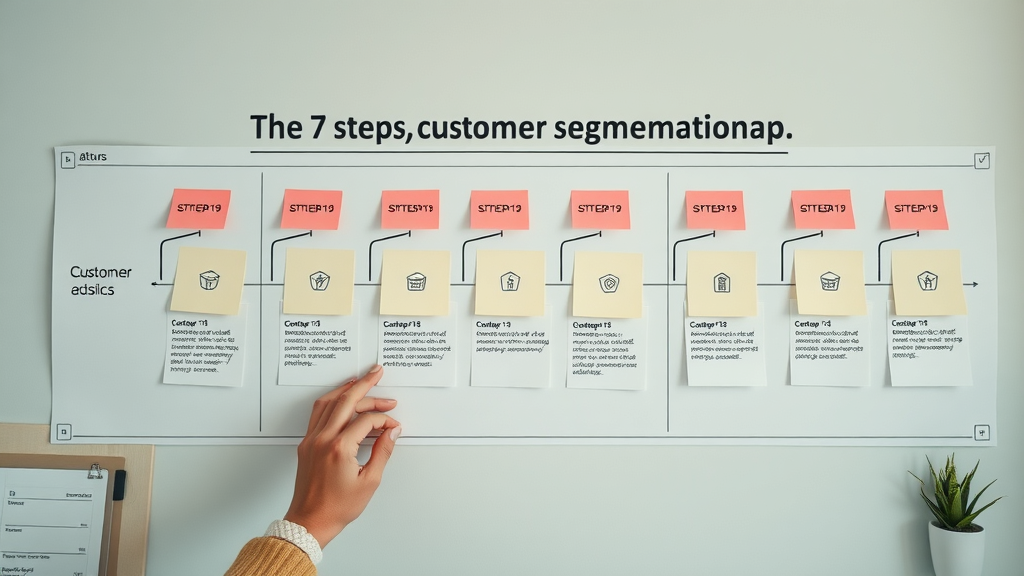Did you know over 65% of marketers admit that poor customer segmentation directly impacts their ROI —and most don't realize they're making critical errors? In an era where precision marketing is king, failing to segment your customers accurately can quietly drain your revenue, shrink your relevance, and stall your business growth. If you want to turn every customer interaction into a winning moment, it's time to recognize the most common segmentation pitfalls and learn how to expertly avoid them.
This comprehensive guide will equip you with a clear understanding of customer segmentation , highlight key mistakes that can quietly sabotage your marketing efforts, and give you actionable strategies that align your products and campaigns with the people who matter most.

Why Customer Segmentation Mistakes Lead to Lost Revenue and Relevance
"Over 65% of marketers admit that poor customer segmentation directly impacts their ROI—and most don't realize they're making critical errors."
Customer segmentation mistakes don't just hinder marketing—they erode brand trust and cost businesses millions in lost opportunities each year. When companies fail to segment customers based on actionable data, their messages miss the mark, resulting in wasted marketing spend and declining engagement rates. More importantly, unrefined segmentation ignores the diversity of your customer base and leads to generic campaigns that simply don’t resonate.
For example, a retail company relying solely on outdated demographic segmentation may send promotion emails to the wrong age group or location, alienating potential customers. By overlooking behavioral segmentation or psychographic insights—such as interests, purchase frequency, or values—companies risk missing out on high-intent audience segments just waiting to be reached with the right message. The path to scalable growth starts with understanding these pitfalls before they quietly undermine your entire marketing strategy.
Customer Segmentation Basics: Understanding the Importance of Segmenting Customers
-
A quick overview of customer segment definition
-
The purposes and goals of customer segmentation in modern marketing
-
Difference between customer segmentation, customer segments, and segmenting customers
Customer segmentation is the process of dividing your customer base into smaller groups based on shared characteristics like geography, behavior, or interests. This approach helps companies understand the needs and motivations of each audience segment, enabling them to deliver personalized experiences and effective marketing campaigns that drive higher engagement and conversions.
The main purpose of customer segmentation in today's marketing environment is to go beyond broad-based messaging and develop a targeted approach. Effective segmentation helps businesses identify their most valuable customers, tailor product offerings, and optimize marketing efforts . While customer segments refer to the specific groups identified, segmenting customers is the active process of analyzing data and creating these distinct segments. Properly understanding these differences is the foundation of a successful segmentation strategy.

Customer Experience, Customer Data, and the Foundation of Customer Segments
A great customer experience starts with rich, accurate customer data . The core of effective customer segments lies in continuously gathering and analyzing a variety of information: demographics, behaviors, purchase patterns, digital engagement, and even marital status . This foundation allows marketers to predict needs, personalize messages, and build strategies that resonate on a personal level.
When customer data is siloed or outdated, segmentation efforts lose their edge. Top-performing companies prioritize data integrity—ensuring that every segment reflects up-to-date preferences and behaviors. As a result, they consistently deliver relevant, timely offers and create memorable experiences that transform casual buyers into loyal fans.
Remember: updating your segmentation model as customer behaviors and expectations evolve is essential to maintaining relevance and maximizing the impact of every campaign.
Top Customer Segmentation Mistakes Businesses Make (and How to Fix Them)
-
Neglecting Behavioral and Psychographic Segmentation
-
Overlooking Demographic Segmentation and Geographic Segmentation
-
Failing to Regularly Update Customer Data
-
Assuming All Customers Based on Simple Metrics
-
Using an Ineffective Segmentation Model
-
Ignoring Marital Status, Demographic Segment Details, and Customer Behavior
|
Common Mistakes |
Potential Impact |
How to Fix |
|---|---|---|
|
Neglecting psychographic segmentation |
Unclear marketing efforts |
Integrate customer behavior data |
|
Relying only on demographic info |
Missed customer experience opportunities |
Add behavioral segmentation |
|
Outdated segmentation model |
Reduced effectiveness |
Audit and update approaches |
|
Ignoring marital status and other key demographic data |
Missed niche marketing |
Expand demographic segmentation criteria |
|
Assuming all customers fit one profile |
Generic messaging and lower ROI |
Describe each audience segment with detail |

Key Elements of an Effective Customer Segmentation Strategy
Collecting Accurate Customer Data: The Foundation of Customer Segments
Gathering quality customer data is the bedrock of any effective customer segmentation strategy. This means pulling information from diverse sources—transaction history, surveys, website analytics, social media behavior, and even customer service logs. The more comprehensive and reliable your data, the better you'll be at recognizing subtle shifts in your customer base and identifying emerging trends among audience segments.
Data collection must be continuous and systematic. Regular audits ensure you aren’t relying on outdated information, helping you create customer segments that truly reflect your market. Companies leading in their industry frequently use advanced CRM systems and AI-based analytics to capture, cleanse, and categorize their data for smarter, more strategic segmenting of customers.

Choosing the Right Segmentation Model for Your Business
Selecting a suitable segmentation model is crucial—what works for a fashion retailer might be impractical for a B2B SaaS firm. There are four principal segmentation types: demographic, geographic, psychographic, and behavioral. Each model offers unique insights and should be chosen based on your business goals and product or service offerings.
An effective segmentation model often combines two or more approaches. For example, a company may use demographic segmentation (age and income) alongside behavioral data (purchase frequency) to create nuanced, actionable customer segments. By evaluating your target audience, regularly updating models, and aligning them with evolving marketing strategies, you keep your business agile and competitive.

Behavioral Segmentation, Psychographic Segmentation, and Geographic Segmentation: Going Beyond Demographics
While demographic segmentation (age, gender, income) forms the backbone, going further with behavioral segmentation , psychographic segmentation , and geographic segmentation ensures marketing efforts are finely tuned to real customer needs. Behavioral segmentation groups customers by their actions—like purchase history or product usage. Psychographic segmentation digs deeper into interests, values, attitudes, and lifestyles. Geographic segmentation places customers into regional clusters for location-specific marketing.
Businesses that blend these segmentation types avoid oversimplified messages. For example, two customers of the same age and income—but different values or online behaviors—will respond best to personalized experiences that address their unique motivations. Overlooking these factors limits your ability to engage, convert, and delight diverse groups.

Case Studies: How Improved Customer Segmentation Enhanced Customer Experience
One global e-commerce brand struggled to increase sales despite high traffic. By auditing their segmentation model, they discovered their customer segments were based only on broad demographic data. After integrating behavioral and psychographic segmentation—tracking browsing history, values, and digital device preferences—they created targeted marketing campaigns that spoke directly to high-value segments. The result? A 27% lift in click-through rates and substantial gains in repeat purchases.
Another case involved a financial services company that used outdated customer data for segmenting customers. Once they switched to real-time analytics for monitoring customer behavior, they identified new niche segments, launched personalized offers, and increased conversion rates by 33%. These examples highlight the power of continuous, multi-dimensional segmentation in transforming the customer experience and maximizing ROI.
Investing in customer segmentation not only optimizes marketing efforts but also boosts customer loyalty by delivering a truly personalized experience that sets your brand apart.
The Critical Role of Customer Behavior in Segmenting Customers Effectively
-
How customer behavior informs customer segments
-
The impact of behavior-based vs demographic segment approaches
"Understanding your customers based on their actions is as vital as knowing their age or geography."
Customer behavior is the single most important driver when you segment customers effectively. Actions—purchases, website visits, content interactions—reveal far more about intent and motivation than age or income ever could. By consistently updating your segmentation model with behavior-derived insights, you can align your messaging and offers to what truly matters for each audience segment.
Compared to purely demographic segments, behavior-based approaches unlock deeper customer understanding and fuel more relevant marketing campaigns. For example, targeting customers who abandoned carts or downloaded a specific guide allows for hyper-personalized follow-ups—with far better conversion potential than generic promotional blasts sent by demographic segment alone.

Leveraging Customer Data to Optimize Marketing Efforts and Enhance Customer Experience
Turning Insights into Action: Aligning Marketing Efforts with Customer Segments
It’s not enough to simply collect and analyze customer data . Winning companies turn those insights into bold actions—aligning marketing efforts with each unique customer segment . This means developing tailored messaging, offers, and content for every stage of the customer journey, and ensuring that your marketing strategy evolves alongside your audience’s behaviors and preferences.
For example, if data shows that a high-value segment prefers educational content over direct sales pitches, you can swap aggressive ads for helpful guides or how-to videos. When you fully align your marketing strategy with the nuanced needs of your segments based on customer behavior, you’ll see tangible improvements—not just in engagement and revenue, but in long-term customer loyalty.

How to Continuously Improve Your Segmentation Model and Customer Segments
-
Monitor and analyze shifting customer experience trends
-
Update segmentation models regularly based on new customer data
-
Encourage feedback from customer segments to refine strategies
Continuous improvement is the hallmark of effective customer segmentation. The market, technology, and consumer expectations are always changing. By monitoring emerging customer experience trends and refreshing your segmentation model with new or updated customer data, you ensure your marketing and sales strategies remain effective.
Collect feedback from every customer segment and integrate it into your strategy. Consider surveys, interviews, or digital feedback loops—these can reveal pain points or emerging interests. Adopt a mindset of ongoing iteration so your segmentation strategy is always moving forward.
Staying proactive with customer segmentation doesn’t just avoid costly mistakes; it powers sustainable growth and agility, helping your business anticipate and capitalize on what's next.

What are the 4 types of customer segmentation?
Answer: The primary types are demographic segmentation, geographic segmentation, psychographic segmentation, and behavioral segmentation—each critical for identifying distinct customer segments.
What is meant by customer segmentation?
Answer: Customer segmentation is the process of dividing a customer base into distinct groups (customer segments) based on shared characteristics to tailor marketing and customer experience more effectively.
What are the 7 steps in the segmentation process?
Answer: Define your market, segment customers using key data, analyze each segment, choose target segments, develop segmentation models, implement tailored marketing efforts, and monitor segment performance.

What is an example of a customer segment?
Answer: An example customer segment: "Young professionals aged 25-35 in urban settings, interested in eco-friendly products and digital experiences."
Expert Insights: Quotes from Industry Leaders on Customer Segmentation
"The future of marketing belongs to brands who understand their customer segments deeply and act on those insights." – Industry CMO
Most Overlooked Customer Segmentation Mistakes in Digital Marketing
Failure to Integrate Multiple Segmentation Approaches
Digital marketers often overlook the power of combining segmentation strategies. Relying only on demographic or location-based segmentation may result in missed opportunities to connect deeply with potential customer groups. By integrating behavioral, psychographic, and demographic segmentation, you can identify richer, more valuable customer segments that fuel higher conversions and loyalty.
A well-integrated approach allows you to build nuanced profiles that can be adapted over time. This ensures relevant messaging and product recommendations that are more likely to meet the evolving needs of each audience segment, bridging the gap between data and actionable marketing efforts.
Poor Alignment Between Customer Segments and Marketing Efforts
Another frequent mistake is a lack of coordination between identified customer segments and the way marketing campaigns are executed. If each customer segment’s preferences and behaviors are not reflected in campaign design, messaging, and channels, your initiatives will fail to maximize ROI.
Ensure that every marketing effort ties directly to a segment’s unique needs. This demands ongoing dialogue between data teams and campaign managers, reinforcing the need for integrated, agile segmentation models that adapt swiftly to new customer insights.
Lists of Do’s and Don’ts for Effective Customer Segmentation
-
Do: Use qualitative and quantitative customer data
-
Do: Regularly evaluate customer segments
-
Don’t: Rely solely on demographic segmentation
-
Don’t: Ignore evolving customer behavior
How to Leverage Customer Segmentation for Business Growth
Using Customer Segments to Personalize the Customer Experience
Harnessing customer segments to deliver a personalized experience is now a baseline expectation. By segmenting customers based on behavior, interests, or preferences, companies can create relevant offers, tailor website journeys, and recommend products that align closely with each segment’s needs. This not only increases satisfaction but also builds trust and loyalty over time—key drivers in business growth.
For example, segmenting customers based on past purchase data allows you to anticipate what they might need next and proactively reach out. Sending timely and relevant communications to the right customer segment boosts response rates, strengthens relationships, and maximizes customer lifecycle value.

Aligning Customer Segmentation with Marketing Strategies
To truly accelerate business success, your marketing strategies must be anchored in strong customer segmentation practices. This involves mapping customer journey touchpoints, identifying opportunities for personalization, and adapting campaign messaging for each audience segment.
When segmentation strategy and marketing execution are working in tandem, brands enjoy measurable benefits—higher open rates, more conversions, and improved retention. Regularly refine this alignment with feedback and updated customer data to outpace competitors and sustain momentum.
FAQs on Customer Segmentation Mistakes and Best Practices
-
What tools can I use for effective customer segmentation?
Leading tools include advanced CRMs (Salesforce, HubSpot), marketing automation platforms (Marketo, Mailchimp), and analytics solutions (Google Analytics, Tableau). These tools help organize customer data and facilitate segmentation with both out-of-the-box and customizable templates. -
How often should I update my segmentation model?
Update your segmentation model every quarter or whenever you experience significant changes in customer behavior, business goals, or the external market. Regular updates ensure segments remain relevant and actionable. -
What are the signs my customer segments need revising?
Key signs include declining campaign performance, stagnant engagement rates, an increase in unsubscribes, or feedback indicating irrelevant messages. Listen for signals from your metrics and direct customer feedback to prompt timely refinement.
Action Steps: Building Stronger Customer Segments and Avoiding Common Pitfalls
-
Conduct an audit of your current segmentation model
-
Gather and analyze customer data regularly
-
Refine segments based on customer behavior and feedback
Key Takeaways for Mastering Customer Segmentation and Driving Results
-
Customer segmentation mistakes often stem from outdated models and neglected data
-
Integrating psychographic, behavioral, and demographic segmentation is essential
-
Effective segmentation enhances customer experience and marketing efforts
Accelerate Business Growth by Mastering Customer Segmentation Today
Actively update your segmentation model and integrate behavioral, demographic, and psychographic insights to deliver exceptional experiences—unlocking sustainable business growth.
Struggling to make All of your M arketing Strategies Work Together Seamlessly and Effortlessly ? Omni-Channel or Cross-Channel, they Start with Content . Click the Link and Get our Ultimate Guide for Building a Content Marketing Strategy for Small Business.
To deepen your understanding of customer segmentation and avoid common pitfalls, consider exploring the following resources:
-
“Customer Segmentation: A Complete Guide” by SurveyMonkey provides an in-depth look at various segmentation models, including demographic, geographic, psychographic, and behavioral approaches, helping you identify the most effective strategies for your business. ( surveymonkey.com )
-
“What Is Customer Segmentation?” by TechTarget offers a comprehensive definition and explores different types of customer segmentation, such as technographic and needs-based segmentation, to enhance your marketing efforts. ( techtarget.com )
By leveraging these insights, you can refine your segmentation strategies to better align with your customers’ needs and drive business growth.
 Add Row
Add Row  Add
Add 




Write A Comment